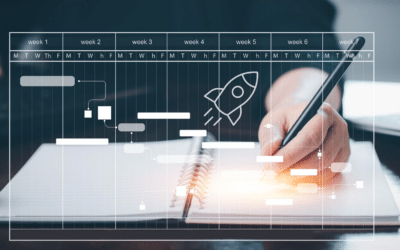Devops Red Flag Warnings
03
JULY, 2019
by Justin Reynolds
Even since the agile manifesto was published in 2001, software development has never been the same.
In a pre-agile world, software was released in monolithic packages every year or every two years. The agile approach to development prioritized faster, more frequent releases that were driven by collaboration between development teams and end users. Instead of following a rigid plan, agile developers were more interested in being flexible so they could quickly respond to change.
Over the last two decades, the agile approach to development has led to the emergence and proliferation of DevOps teams.
According to a recent report, 47% of organizations are currently using some version or interpretation of DevOps. More and more companies will undoubtedly follow suit as we move further into the future—if for no other reason than failing to do so will have disastrous business implications.
Before we explore the benefits of DevOps as well as the major reasons DevOps initiatives fail at organizations, here’s a brief definition.
What Is DevOps?
DevOps is an approach to software development that accelerates release cycles. It combines development and operations teams into a single cohesive unit thereby enabling companies to ship better products on a more frequent basis.
Benefits of DevOps
DevOps provides a number of benefits to organizations, including:
- Increased engagement. Not only does DevOps allow engineers to do their best work, it also increases customer engagement, as user feedback is critical to informing future releases.
- Customer satisfaction. Since DevOps teams work closely with their customers, the products they end up shipping closely align with user expectations—which translates into happier customers.
- Improved agility. Like the agile manifesto, DevOps teams move quickly. Thanks to frequent releases, they are better positioned to respond to changing markets and customer sentiments at a moment’s notice.
- Streamlined collaboration. DevOps-powered organizations are staffed by employees who know the importance of collaboration. They work together with their peers to get more done more effectively in less time.
- Educated employees. On DevOps teams, developers learn operations and members of the ops team learn development. Employees across the organization continue acquiring new skills, increasing their job satisfaction while building a stronger company staffed by increasingly talented individuals.
Altogether, these benefits translate into incredible business outcomes. Companies that have mastered the DevOps mindset, like Amazon, Adobe, and Fidelity, are doing particularly well.
According to Puppet’s 2017 State of DevOps report, DevOps teams enjoy:
- Deploy code 46 times as frequently
- Go from commit to deploy 440 times faster
- Recover 96 times faster
- Experience 1/5th the change failure
While the benefits of DevOps speak for themselves, many organizations have not yet realized the true promise of the DevOps development philosophy.
Here are five common reasons why that happens.
Red Flag #1: Your Team Doesn’t Buy Into the DevOps Philosophy
If you’ve always approach software development the old-fashioned way, launching DevOps at your organization will likely be a tall order. Your developers and ops team will have to change the way they work. Since many people love to resist change because they’re scared of leaving their comfort zones. Enacting the culture shift that DevOps requires can be incredibly hard to do.
In fact, by 2023, 90% of DevOps initiatives will be unsuccessful simply because the people involved in the process aren’t completely on board with the DevOps culture shift.
You might hear a lot of grumbles after announcing your intentions to implement DevOps. You may have to go back to the drawing board to figure out how to better persuade your team to go in the new direction. Remind them about how DevOps can help make their jobs easier while enabling them to do their best work.
Red Flag #2: Creating a New DevOps Team
When you’re launching a DevOps initiative, you might be tempted to create a whole new “DevOps” department. Avoid that temptation.
Instead of creating another silo, DevOps is supposed to break down walls and barriers between engineering and operations departments, as well as the larger business as a whole.
Get your existing team to buy into the new way of working. Once they change their minds and their approach, your DevOps initiatives will bring the efficiency and productivity you’re hoping for to your organization.
Red Flag #3: You Are Not Using Enough Automation
As much as DevOps requires a mindset shift, it also requires the right suite of tools. If you don’t have the right tools in place, your DevOps initiatives will fail. This is because the whole point of DevOps is to speed up development, using software and collaboration to drive the business forward.
Unfortunately, many companies don’t have the right tools.
For example, one study found that 30% of DevOps teams are still using manual processes for deployment. Not only does this slow down development, it also increases the chances human error enters the equation.
With the right tools in place, you can adopt the true DevOps mindset, embracing continuous integration, continuous delivery, and continuous deployment. Thanks to automation, your DevOps team will be able to get more done faster, with fewer errors.
Red Flag #4: You Get Angry When Releases Aren’t Perfect
DevOps is all about iteration. The goal is to release software updates frequently, to be sure. But successful DevOps teams know that every release doesn’t have to be perfect because, well, no release ever is. There’s bound to be at least one bug buried somewhere in the code.
If you or your management team gets upset and angry when releases aren’t flawless, you’re doing DevOps wrong. Instead, the smarter approach is to understand that every release will likely have some areas that need to be improved—and they will be during the next sprint.
Red Flag #5: You’re Not Shipping Frequent Updates
Shipping software updates frequently that are packed with features demanded by the user community? That sounds great!
Unfortunately, many organizations that buy into the promise of DevOps never end up experiencing its full potential. If your team is incapable of shipping frequent updates, there’s something wrong with your DevOps program. It’s that simple.
Of course, not every business needs frequent releases; a company like TurboTax will focus on one major release each year, for example. But if you’re a company that should be releasing updates regularly but you’re struggling to do so, there’s probably a problem.
The good news is that this problem is one that can be fixed. You might need to invest in the right DevOps tools. Or, you’ll need to spend more time persuading your team that DevOps presents the best path forward for your company.
Is It Time to Optimize Your Approach to DevOps?
There’s a reason why today’s leading organizations are all driven by DevOps teams. The approach to software development enables companies to build better products faster and more cost-effectively.
Unfortunately, you can’t just expect to roll out a DevOps initiative at your company and get great results. Successful DevOps teams are 100% on board with the DevOps philosophy. They use the tools designed specifically to support their unique workflows.
Learn more about how you can use modern software to streamline your DevOps workflows, engage your team, and serve your users more effectively.
Justin Reynolds
This post was written by Justin Reynolds. Justin is a freelance writer who enjoys telling stories about how technology, science, and creativity can help workers be more productive. In his spare time, he likes seeing or playing live music, hiking, and traveling.
Relevant Articles
Your Essential Test Environment Management Checklist
“Test Environment Management Checklist.” Yep, that sounds like a mouthful, but don’t let that discourage you. The idea here is quite simple—adopting a checklist to evaluate the soundness of your test environment management approach. Even though the idea sounds simple...
A Detailed Guide to SAP Data Masking
SAP systems handle some of the most sensitive data in the enterprise: financial transactions, HR information, supplier records, customer profiles, operational details, and more. For that reason, copying production data into non-production systems without modification...
Release vs Deployment Management: What’s the Difference?
In the always-an-adventure world of IT service management, there are several key processes that are essential for delivering high-quality services to customers and end-users. Two of the most critical processes are release management and deployment management. These...
7 Tools to Help with Application Rationalization
Application rationalization is the process of identifying which applications an organization should keep, update, consolidate, or retire. Think of it as a financial adviser, but instead of your investment portfolio, it's your application portfolio. Most companies take...
Pairing DevOps with Test Environment Management
For many organizations, DevOps is the best practice for efficiency. However, this model doesn’t come easily as the organization needs to put certain things in place. For example, the firm needs to incorporate the right tools to ensure its delivery pipeline and...
8 DevOps Anti-Patterns You Should Avoid
It’s the normal case with software buzzwords that people focus so much on what something is that they forget what it is not. DevOps is no exception. To truly embrace DevOps and cherish what it is, it’s important to comprehend what it isn’t. A plethora...










